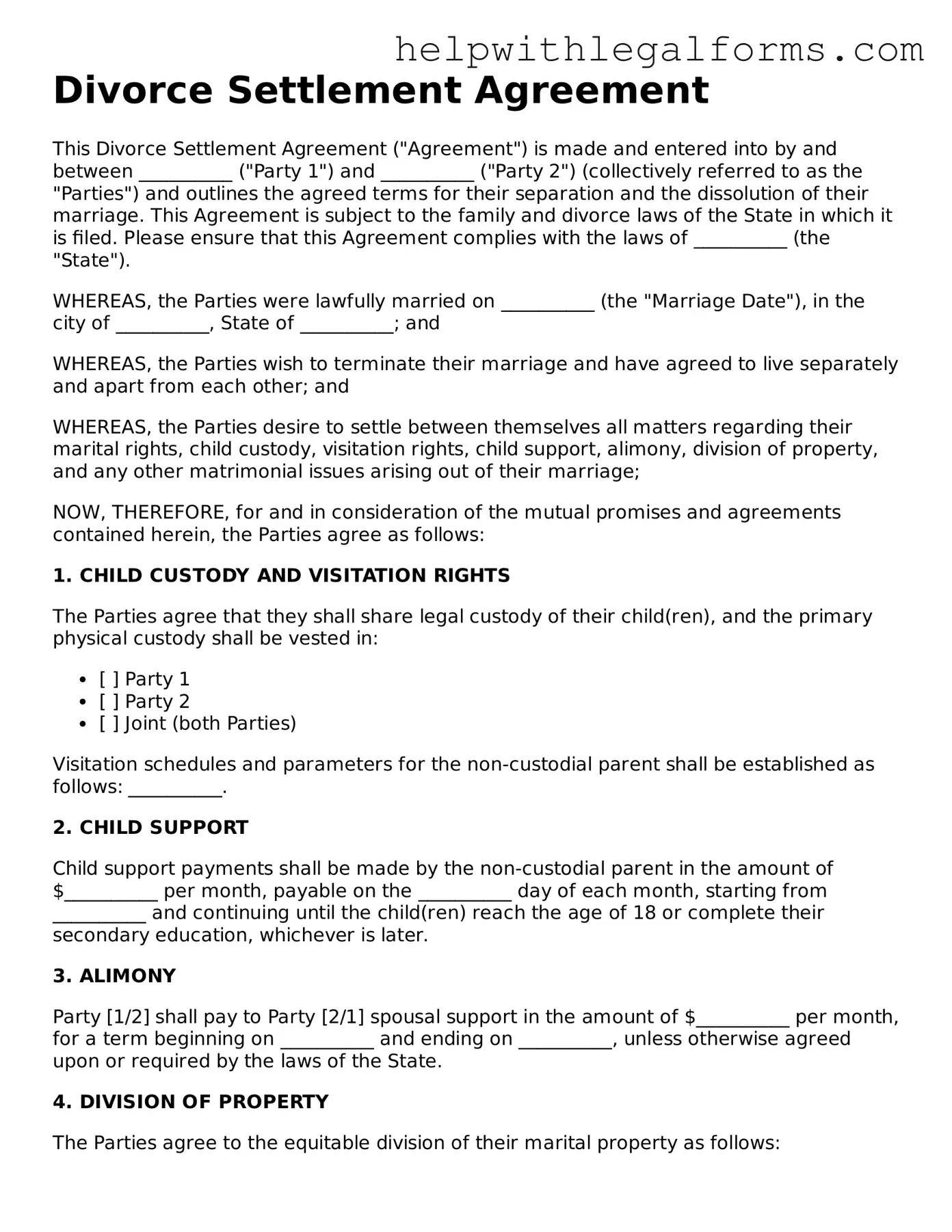Divorce Settlement Agreement
This Divorce Settlement Agreement ("Agreement") is made and entered into by and between __________ ("Party 1") and __________ ("Party 2") (collectively referred to as the "Parties") and outlines the agreed terms for their separation and the dissolution of their marriage. This Agreement is subject to the family and divorce laws of the State in which it is filed. Please ensure that this Agreement complies with the laws of __________ (the "State").
WHEREAS, the Parties were lawfully married on __________ (the "Marriage Date"), in the city of __________, State of __________; and
WHEREAS, the Parties wish to terminate their marriage and have agreed to live separately and apart from each other; and
WHEREAS, the Parties desire to settle between themselves all matters regarding their marital rights, child custody, visitation rights, child support, alimony, division of property, and any other matrimonial issues arising out of their marriage;
NOW, THEREFORE, for and in consideration of the mutual promises and agreements contained herein, the Parties agree as follows:
1. CHILD CUSTODY AND VISITATION RIGHTS
The Parties agree that they shall share legal custody of their child(ren), and the primary physical custody shall be vested in:
- [ ] Party 1
- [ ] Party 2
- [ ] Joint (both Parties)
Visitation schedules and parameters for the non-custodial parent shall be established as follows: __________.
2. CHILD SUPPORT
Child support payments shall be made by the non-custodial parent in the amount of $__________ per month, payable on the __________ day of each month, starting from __________ and continuing until the child(ren) reach the age of 18 or complete their secondary education, whichever is later.
3. ALIMONY
Party [1/2] shall pay to Party [2/1] spousal support in the amount of $__________ per month, for a term beginning on __________ and ending on __________, unless otherwise agreed upon or required by the laws of the State.
4. DIVISION OF PROPERTY
The Parties agree to the equitable division of their marital property as follows:
- Real estate located at __________ shall be [granted to / sold and proceeds divided between] the Parties.
- Automobiles and other vehicles (describe): __________ shall be assigned to __________.
- Bank account(s) and other liquid assets shall be divided as follows: __________.
- Retirement and pension accounts shall be divided in accordance with __________ [specify agreement or state law provision].
- Personal property, including furniture, jewelry, and others, shall be distributed as follows: __________.
5. DEBTS AND LIABILITIES
The Parties hereby agree on the allocation of all debts and liabilities accrued during the marriage as follows: __________. Each Party agrees to pay their respective shares and to indemnify and hold the other Party harmless from such debts.
6. ENTIRE AGREEMENT
This Agreement, including any attachments and exhibits hereto, constitutes the entire agreement between the Parties concerning the subject matter hereof and supersedes all previous agreements, promises, proposals, representations, understandings, and negotiations, whether written or oral, between the Parties regarding the subject matter.
7. AMENDMENT AND MODIFICATION
No modification, change, or amendment of this Agreement shall be valid or binding unless in writing and signed by both Parties.
8. GOVERNING LAW
This Agreement shall be governed by and construed in accordance with the laws of the State of __________, without regard to its conflict of law principles.
IN WITNESS WHEREOF, the Parties have executed this Agreement as of the date first above written:
Party 1 Signature: ___________________________ Date: __________
Party 2 Signature: ___________________________ Date: __________
